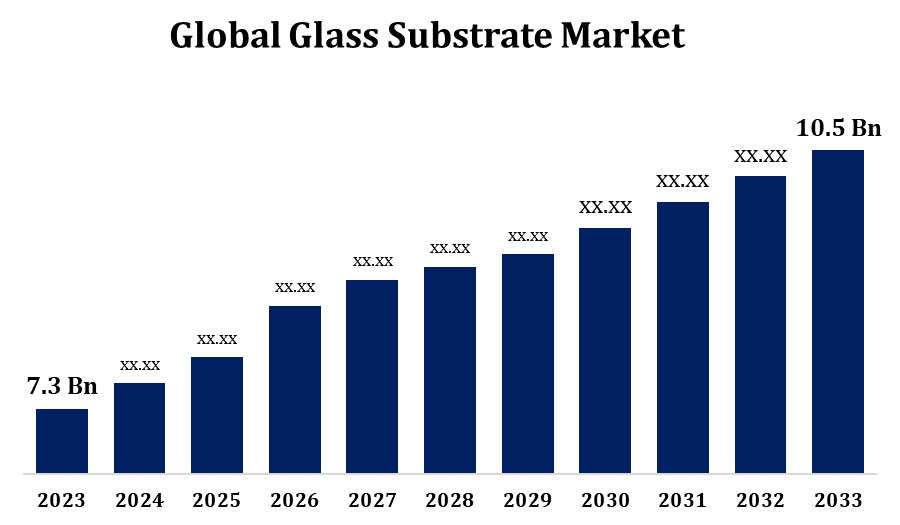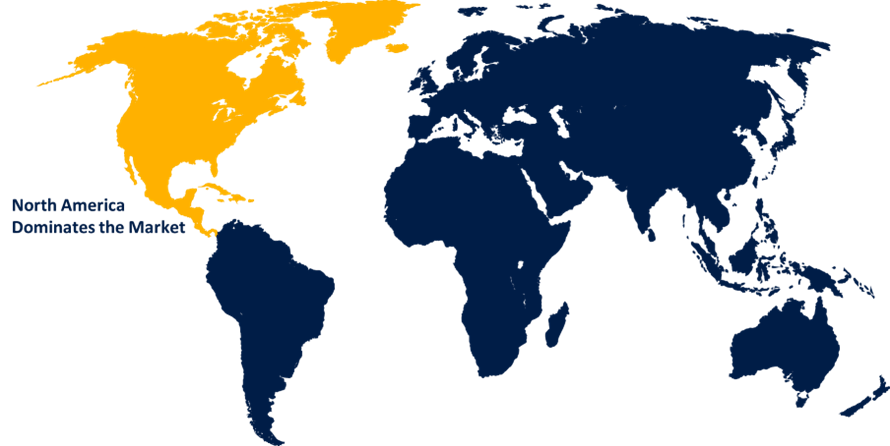Global Glass Substrate Market Size To Worth USD 10.5 Billion By 2033 | CAGR of 3.70%
Category: Chemicals & MaterialsGlobal Glass Substrate Market Size To Worth USD 10.5 Billion By 2033
According to a research report published by Spherical Insights & Consulting, the Global Glass Substrate Market Size to Grow from USD 7.3 Billion in 2023 to USD 10.5 Billion by 2033, at a Compound Annual Growth Rate (CAGR) of 3.70% during the forecast period.

Get more details on this report -
Browse key industry insights spread across 215 pages with 110 Market data tables and figures & charts from the report on the "Global Glass Substrate Market Size, Share, and COVID-19 Impact Analysis, By Type (Borosilicate, Silicon, Fused Silica/Quartz, Aluminosilicate, Ceramic), By End-use Industry (Electronics, Automotive, Healthcare, Aerospace & Defense, Energy), and By Region (North America, Europe, Asia-Pacific, Latin America, Middle East, and Africa), Analysis and Forecast 2023 - 2033." Get Detailed Report Description Here:https://www.sphericalinsights.com/reports/glass-substrate-market
The glass substrate market is experiencing growth fueled by rising demand in the electronics, automotive, and solar sectors. Renowned for their durability, optical clarity, and chemical stability, glass substrates are crucial for producing flat-panel displays, photovoltaic modules, and automotive displays. Advancements in electronics, particularly in semiconductors and display technology, are increasing the need for high-quality glass substrates. Additionally, the emergence of flexible displays and miniaturized devices is prompting manufacturers to focus on ultra-thin and lightweight glass solutions. The Asia-Pacific region leads the market, driven by prominent electronics and automotive manufacturers, while North America and Europe are also seeing steady growth thanks to innovation. Nonetheless, challenges such as high production costs and complex manufacturing processes persist, though ongoing R&D efforts are focused on addressing these issues.
Glass Substrate Market Value Chain Analysis
The value chain of the glass substrate market encompasses several critical stages, starting from raw material sourcing to end-user applications. The process initiates with suppliers delivering high-purity silica and other essential materials to manufacturers. These raw materials undergo processing through melting, forming, and coating to create high-quality glass substrates that meet specific requirements, such as thinness and optical clarity, for diverse applications. Manufacturers of glass substrates serve industries like electronics, automotive, and solar energy, working closely with original equipment manufacturers (OEMs) to fulfill precise specifications. Distributors and retailers play a vital role in managing logistics and supporting the supply chain. Technological advancements, such as automation and precision engineering, are enhancing the production process, while the demand for specialized substrates, including ultra-thin and flexible glass, is spurring innovation throughout the entire value chain.
Glass Substrate Market Opportunity Analysis
The glass substrate market offers numerous growth opportunities, especially with the increasing demand in the electronics, renewable energy, and automotive sectors. As the electronics industry evolves, there is a growing requirement for ultra-thin and lightweight glass substrates in products such as OLED displays, smartphones, and wearable devices. The renewable energy sector, propelled by the transition to clean energy, is generating substantial demand for glass substrates used in solar photovoltaic (PV) panels, where their durability and transparency contribute to enhanced energy efficiency. Additionally, the automotive industry's shift toward digital dashboards and head-up displays in electric vehicles is driving the need for specialized glass substrates. Emerging technologies, including flexible displays and miniaturized semiconductor devices, are further expanding market potential, encouraging manufacturers to innovate in materials, production methods, and sustainable solutions to seize these evolving opportunities.
The expansion of the photovoltaic (PV) sector is a key driver for the glass substrate market, as these substrates are essential for enhancing the performance and durability of solar panels. A growing global emphasis on renewable energy and stringent environmental regulations is accelerating the adoption of solar energy, resulting in an increased demand for high-quality glass substrates in PV applications. These substrates contribute to improved light transmittance, durability, and resistance to extreme environmental conditions, making them ideal for use in PV modules. Governments around the world are promoting solar initiatives through incentives and subsidies, further boosting demand. Moreover, advancements in PV technology, including bifacial modules and ultra-thin solar panels, are prompting manufacturers to develop innovative glass substrates that align with these emerging standards, ultimately fostering market growth and innovation in the industry.
The production of high-quality glass substrates demands meticulous handling and sophisticated technologies, leading to elevated production costs that can hinder affordability and limit market growth. Additionally, the costs of raw materials, especially high-purity silica, can fluctuate, affecting overall production expenses. Environmental concerns and regulatory requirements regarding emissions from manufacturing processes add further complexity, necessitating investments in sustainable practices. The fast pace of technological advancements also compels manufacturers to continually upgrade their equipment and innovate, which can be capital-intensive. Lastly, competition from alternative materials, such as plastic substrates used in flexible applications, presents a potential threat, prompting glass manufacturers to find ways to differentiate their products.
Insights by Type
The borosilicate segment accounted for the largest market share over the forecast period 2023 to 2033. The borosilicate segment of the glass substrate market is experiencing significant growth, primarily due to its exceptional thermal and chemical resistance. Renowned for its high durability and low thermal expansion, borosilicate glass is ideal for applications in high-temperature settings, such as laboratory equipment, semiconductor manufacturing, and photovoltaics. Its stability under extreme conditions makes it particularly suitable for solar panels, where it contributes to enhanced longevity and performance across varying weather conditions. Electronics manufacturers are increasingly opting for borosilicate substrates in display technologies for advanced smartphones and tablets, as these substrates offer both clarity and resistance to thermal shock. With continuous innovations and a rising demand for high-performance materials across industries like automotive, renewable energy, and electronics, the borosilicate segment is projected to grow, reinforcing its significance in the glass substrate market.
Insights by End User
The automotive segment accounted for the largest market share over the forecast period 2023 to 2033. Glass substrates play a crucial role in the production of digital displays, head-up displays (HUDs), and touch screens, which are becoming increasingly standard in modern vehicles. As automotive manufacturers integrate more infotainment systems and digital interfaces, the demand for durable, high-quality glass substrates that offer scratch resistance, clarity, and heat tolerance is on the rise. Electric vehicles (EVs) and luxury cars, in particular, prioritize sleek, high-tech displays that necessitate thin and optically clear substrates. Furthermore, the growth of smart and connected car technologies is driving the need for sensors and screens, which further boosts the demand for specialized glass substrates. Overall, this trend positions the automotive segment as a significant driver of market growth.
Insights by Region

Get more details on this report -
North America is anticipated to dominate the Glass Substrate Market from 2023 to 2033. The region's emphasis on technological innovation and advanced manufacturing has driven the adoption of high-quality glass substrates in products such as high-resolution displays, semiconductors, and photovoltaic panels. The increasing interest in electric vehicles (EVs) and the corresponding growth of digital dashboard displays are boosting demand within the automotive sector. Additionally, the United States and Canada are investing in solar energy initiatives, heightening the need for durable and efficient glass substrates in photovoltaic (PV) applications. However, high production costs and competition from lower-cost regions present challenges. To stay competitive, North American manufacturers are prioritizing research and development to create innovative, cost-effective, and sustainable glass substrate solutions.
Asia Pacific is witnessing the fastest market growth between 2023 to 2033. The strong demand for consumer electronics, including smartphones, tablets, and OLED displays, is driving the need for advanced glass substrates characterized by thinness, durability, and optical precision. The region also serves as a major center for solar energy production, with significant investments in photovoltaic (PV) infrastructure, which further boosts the market for glass substrates utilized in PV modules. Competitive production costs and a skilled labor force reinforce Asia-Pacific’s market leadership. However, increasing environmental regulations and the challenge of maintaining quality standards during mass production are prompting manufacturers to invest in sustainable practices and advanced technologies to improve production efficiency and comply with global standards.
Recent Market Developments
- On November 2023, AUO Corp., a flat panel supplier, has initiated the second phase of operations for its sixth-generation Low-Temperature Polycrystalline Silicon (LTPS) LCD fabrication facility in Kunshan, China, aimed at enhancing glass substrate production.
Major players in the market
- AGC Inc.
- SCHOTT
- AvanStrate Inc.
- Dongxu Group Co., Ltd.
- Irico Group New Energy Company Limited
- TECNISCO, LTD.
- Corning Incorporated.
- Nippon Electric Glass Co., Ltd.
- HOYA Corporation.
- Plan Optik AG
- Ohara Inc.
Market Segmentation
This study forecasts revenue at global, regional, and country levels from 2023 to 2033.
Glass Substrate Market, Type Analysis
- Borosilicate
- Silicon
- Fused Silica/Quartz
- Aluminosilicate
- Ceramic
Glass Substrate Market, End Use Analysis
- Electronics
- Automotive
- Healthcare
- Aerospace & Defense
- Energy
Glass Substrate Market, Regional Analysis
- North America
- US
- Canada
- Mexico
- Europe
- Germany
- Uk
- France
- Italy
- Spain
- Russia
- Rest of Europe
- Asia Pacific
- China
- Japan
- India
- South Korea
- Australia
- Rest of Asia Pacific
- South America
- Brazil
- Argentina
- Rest of South America
- Middle East & Africa
- UAE
- Saudi Arabia
- Qatar
- South Africa
- Rest of the Middle East & Africa
About the Spherical Insights & Consulting
Spherical Insights & Consulting is a market research and consulting firm which provides actionable market research study, quantitative forecasting and trends analysis provides forward-looking insight especially designed for decision makers and aids ROI.
Which is catering to different industry such as financial sectors, industrial sectors, government organizations, universities, non-profits and corporations. The company's mission is to work with businesses to achieve business objectives and maintain strategic improvements.
CONTACT US:
For More Information on Your Target Market, Please Contact Us Below:
Phone: +1 303 800 4326 (the U.S.)
Phone: +91 90289 24100 (APAC)
Email: inquiry@sphericalinsights.com, sales@sphericalinsights.com
Contact Us: https://www.sphericalinsights.com/contact-us
Need help to buy this report?